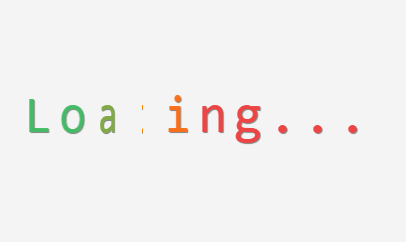
In the previous article "Use CSS3 to create a cool triangle background image", we introduced the method of using CSS3 to create a cool triangle background. This time we continue to share CSS3 effects and see how to use pure CSS3 to achieve loading animation effects. If you are interested, you can learn about it~
When entering a website, because many pictures need to be displayed, it often takes a while to load. . If you add a dynamic loading effect here, it will not make waiting boring. For example, the picture below looks like this:
#This article will share with you two loading animation effects achieved using CSS3. Both methods are implemented using animation and @keyframes. Let’s take a look at the implementation code:
How to achieve the first effect:
<!DOCTYPE html>
<html>
<head>
<meta charset="utf-8">
<style type="text/css">
html,
body {
padding: 0;
height: 100%;
display: table;
margin: 0 auto;
font-size: 52px;
font-family: Monaco, Consolas, "Lucida Console", monospace;
background-image: url("http://subtlepatterns.subtlepatterns.netdna-cdn.com/patterns/kindajean.png");
}
.loading {
text-align: center;
display: table-cell;
vertical-align: middle;
text-shadow: grey 1px 1px 1px;
}
.letter {
float: left;
width: 35px;
height: 60px;
position: relative;
-webkit-animation: flip 2s infinite;
-webkit-transform-style: preserve-3d;
-webkit-transition: -webkit-transform 1s;
}
.letter div {
width: 100%;
height: 100%;
position: absolute;
-webkit-transform: translate(0);
-webkit-backface-visibility: hidden;
-webkit-animation: color 8s infinite;
}
.letter div.back {
-webkit-transform: rotateY(180deg);
}
.letter:nth-child(1),
.letter:nth-child(1) div {
-webkit-animation-delay: 0.125s;
}
.letter:nth-child(2),
.letter:nth-child(2) div {
-webkit-animation-delay: 0.25s;
}
.letter:nth-child(3),
.letter:nth-child(3) div {
-webkit-animation-delay: 0.375s;
}
.letter:nth-child(4),
.letter:nth-child(4) div {
-webkit-animation-delay: 0.5s;
}
.letter:nth-child(5),
.letter:nth-child(5) div {
-webkit-animation-delay: 0.625s;
}
.letter:nth-child(6),
.letter:nth-child(6) div {
-webkit-animation-delay: 0.75s;
}
.letter:nth-child(7),
.letter:nth-child(7) div {
-webkit-animation-delay: 0.875s;
}
.letter:nth-child(8),
.letter:nth-child(8) div {
-webkit-animation-delay: 1s;
}
.letter:nth-child(9),
.letter:nth-child(9) div {
-webkit-animation-delay: 1.125s;
}
.letter:nth-child(10),
.letter:nth-child(10) div {
-webkit-animation-delay: 1.25s;
}
@-webkit-keyframes flip {
0% {
-webkit-transform: rotateY(0deg) translate(0);
}
40%,
100% {
-webkit-transform: rotateY(180deg) translate(0);
}
}
@-webkit-keyframes color {
0% {
color: #88E488;
}
25% {
color: #EEADB7;
}
50% {
color: #90C9DB;
}
75% {
color: #F3B034;
}
100% {
color: #828282;
}
}
</style>
</head>
<body>
<div class="loading">
<div class="letter">
<div>L</div>
<div class="back">L</div>
</div>
<div class="letter">
<div>o</div>
<div class="back">o</div>
</div>
<div class="letter">
<div>a</div>
<div class="back">a</div>
</div>
<div class="letter">
<div>d</div>
<div class="back">d</div>
</div>
<div class="letter">
<div>i</div>
<div class="back">i</div>
</div>
<div class="letter">
<div>n</div>
<div class="back">n</div>
</div>
<div class="letter">
<div>g</div>
<div class="back">g</div>
</div>
<div class="letter dot">
<div>.</div>
<div class="back">.</div>
</div>
<div class="letter dot">
<div>.</div>
<div class="back">.</div>
</div>
<div class="letter dot">
<div>.</div>
<div class="back">.</div>
</div>
</div>
</body>
</html>In the above code, first use two animation attributes to bind two animations, flip and color, to each word to control the flip action and color change respectively; then use the @keyframes rule to bind the two animations respectively. Just set the action for each frame of the animation.
The flip action needs to be controlled using the transform attribute, which can apply 2D or 3D transformation to the element.
The effect is as follows:

The following effect is also the same realization idea, but there are some changes in subtleties.
How to achieve the second effect:
<!DOCTYPE html>
<html>
<head>
<meta charset="utf-8">
<style>
html,
body {
padding: 0;
height: 100%;
display: table;
margin: 0 auto;
font-size: 52px;
font-family: Monaco, Consolas, "Lucida Console", monospace;
background: #F5F5F5;
}
.loading {
top: 50%;
left: 50%;
width: 350px;
height: 60px;
font-size: 52px;
position: absolute;
text-align: center;
margin-top: -30px;
margin-left: -175px;
text-shadow: #808080 1px 1px 1px;
font-family: Monaco, Consolas, "Lucida Console", monospace;
}
.letter {
float: left;
width: 35px;
height: 60px;
position: relative;
animation: flip 2s infinite;
transform-style: preserve-3d;
transition: transform 1s;
}
.letter div {
color: #4B6;
width: 100%;
height: 100%;
position: absolute;
transform: translate(0);
backface-visibility: hidden;
animation: color 16s infinite;
}
.letter div.back {
transform: rotateY(180deg);
}
.letter:nth-child(1),
.letter:nth-child(1) div {
animation-delay: 0.125s;
}
.letter:nth-child(2),
.letter:nth-child(2) div {
animation-delay: 0.25s;
}
.letter:nth-child(3),
.letter:nth-child(3) div {
animation-delay: 0.375s;
}
.letter:nth-child(4),
.letter:nth-child(4) div {
animation-delay: 0.5s;
}
.letter:nth-child(5),
.letter:nth-child(5) div {
animation-delay: 0.625s;
}
.letter:nth-child(6),
.letter:nth-child(6) div {
animation-delay: 0.75s;
}
.letter:nth-child(7),
.letter:nth-child(7) div {
animation-delay: 0.875s;
}
.letter:nth-child(8),
.letter:nth-child(8) div {
animation-delay: 1s;
}
.letter:nth-child(9),
.letter:nth-child(9) div {
animation-delay: 1.125s;
}
.letter:nth-child(10),
.letter:nth-child(10) div {
animation-delay: 1.25s;
}
@keyframes flip {
0% {
transform: rotateY(0deg) translate(0);
}
40%,
100% {
transform: rotateY(180deg) translate(0);
}
}
@keyframes color {
1.5% {
color: #6AD;
}
3%,
12.5% {
color: #F80;
}
14% {
color: #4B6;
}
15.5%,
25% {
color: #F68;
}
26.5% {
color: #C83;
}
28%,
37.5% {
color: #96C;
}
39% {
color: #C83;
}
40.5%,
50% {
color: #E44;
}
51.5% {
color: #F80;
}
53%,
62.5% {
color: #4B6;
}
64% {
color: #F68;
}
65.5%,
75% {
color: #C83;
}
76.5% {
color: #96C;
}
78%,
87.5% {
color: #6AD;
}
89% {
color: #F80;
}
90.5%,
100%,
0% {
color: #4B6;
}
}
</style>
</head>
<body>
<div class="loader">
<div class="loading">
<div class="letter">
<div>L</div>
<div class="back">L</div>
</div>
<div class="letter">
<div>o</div>
<div class="back">o</div>
</div>
<div class="letter">
<div>a</div>
<div class="back">a</div>
</div>
<div class="letter">
<div>d</div>
<div class="back">d</div>
</div>
<div class="letter">
<div>i</div>
<div class="back">i</div>
</div>
<div class="letter">
<div>n</div>
<div class="back">n</div>
</div>
<div class="letter">
<div>g</div>
<div class="back">g</div>
</div>
<div class="letter">
<div>.</div>
<div class="back">.</div>
</div>
<div class="letter">
<div>.</div>
<div class="back">.</div>
</div>
<div class="letter">
<div>.</div>
<div class="back">.</div>
</div>
</div>
</div>
</body>
</html>The effect is as follows:

The following are 3 keys Attribute animation, @keyframes and transform:
CSS3 animation (animation) Attribute
Syntax: animation : name duration timing-function delay iteration-count direction fill-mode play-state;
animation-name:指定要绑定到选择器的关键帧的名称 animation-duration:动画指定需要多少秒或毫秒完成 animation-timing-function:设置动画将如何完成一个周期 animation-delay:设置动画在启动前的延迟间隔。 animation-iteration-count:定义动画的播放次数。 animation-direction:指定是否应该轮流反向播放动画。 animation-fill-mode:规定当动画不播放时(当动画完成时,或当动画有一个延迟未开始播放时),要应用到元素的样式。 animation-play-state:指定动画是否正在运行或已暂停。
@keyframes Rules
Animations can be created using @keyframes rules. Animation is created by gradually changing from one CSS style setting to another. To put it simply: @keyframes is used to set the action of each frame of animation.
@keyframes need to be used together with the animation attribute to achieve animation:
@keyframe rules consist of the keyword "@keyframe", followed by an identifier giving the name of the animation (animation will be used -name), followed by a set of style rules (delimited by curly braces). The animation is then applied to the element by using the identifier as the value of the animation-name attribute. For example:
/* 定义动画*/
@keyframes 动画名称{
/* 样式规则*/
}
/* 将它应用于元素 */
.element {
animation-name: 动画名称(在@keyframes中已经声明好的);
/* 或使用动画简写属性*/
animation: 动画名称 1s ...
}CSS3 transform Properties
The transform property applies a 2D or 3D transformation to an element. This property allows us to rotate, scale, move or tilt the element.
Grammar: transform: none|transform-functions;
none 定义不进行转换。 matrix(n,n,n,n,n,n) 定义 2D 转换,使用六个值的矩阵。 matrix3d(n,n,n,n,n,n,n,n,n,n,n,n,n,n,n,n) 定义 3D 转换,使用 16 个值的 4x4 矩阵。 translate(x,y) 定义 2D 转换。 translate3d(x,y,z) 定义 3D 转换。 translateX(x) 定义转换,只是用 X 轴的值。 translateY(y) 定义转换,只是用 Y 轴的值。 translateZ(z) 定义 3D 转换,只是用 Z 轴的值。 scale(x,y) 定义 2D 缩放转换。 scale3d(x,y,z) 定义 3D 缩放转换。 scaleX(x) 通过设置 X 轴的值来定义缩放转换。 scaleY(y) 通过设置 Y 轴的值来定义缩放转换。 scaleZ(z) 通过设置 Z 轴的值来定义 3D 缩放转换。 rotate(angle) 定义 2D 旋转,在参数中规定角度。 rotate3d(x,y,z,angle) 定义 3D 旋转。 rotateX(angle) 定义沿着 X 轴的 3D 旋转。 rotateY(angle) 定义沿着 Y 轴的 3D 旋转。 rotateZ(angle) 定义沿着 Z 轴的 3D 旋转。 skew(x-angle,y-angle) 定义沿着 X 和 Y 轴的 2D 倾斜转换。 skewX(angle) 定义沿着 X 轴的 2D 倾斜转换。 skewY(angle) 定义沿着 Y 轴的 2D 倾斜转换。 perspective(n) 为 3D 转换元素定义透视视图。
The PHP Chinese website platform has a lot of video teaching resources, everyone is welcome to learn "css video tutorial》!
The above is the detailed content of Use CSS3 to create practical loading animation effects (two types). For more information, please follow other related articles on the PHP Chinese website!